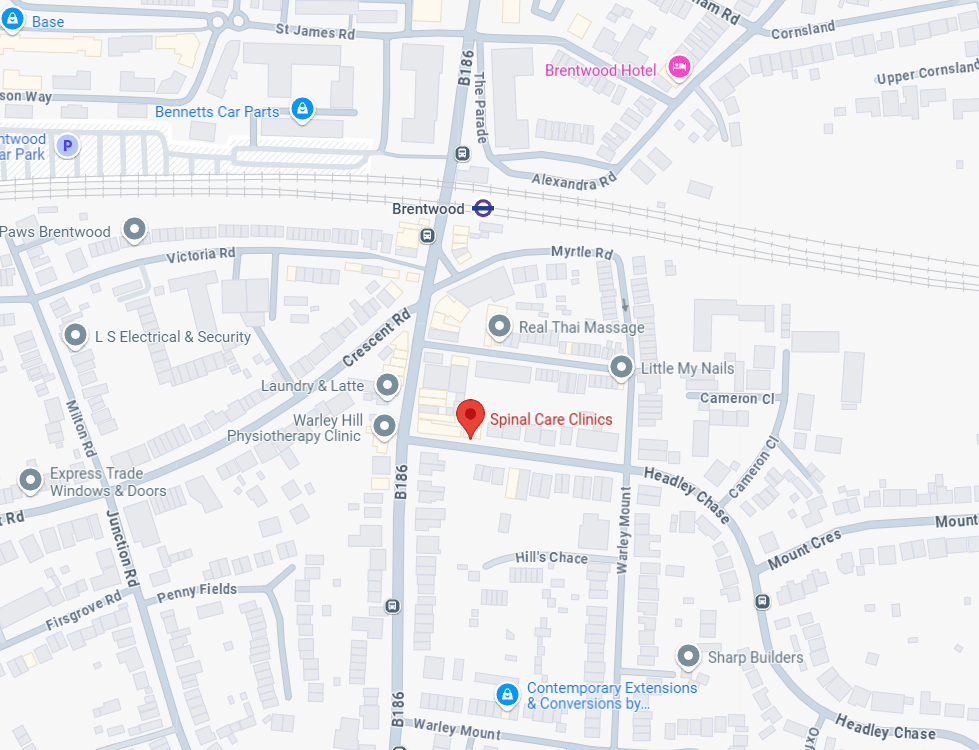If there is one condition we see daily at Spinal Care Clinics in Brentwood it’s sciatica, and we vouch that it’s more than a simple pain in your rear. Sciatica is frustrating and can be debilitating. It can seemingly come out of nowhere and leave you helplessly hunting for clues and answers on the Internet. Pain has many faces with sciatica and some find it hard to describe. We hear of numbness, weakness, burning, or even quite simply, an odd sensation. Often sciatica is characterised by a sharp, travelling pain that starts in your lower back and can radiate down your leg all the way to your toes. Sometimes it can even be coupled with a tingling session, like pins and needles. The pain usually affects only one leg and may get worse when you sit, cough, or sneeze.
So what is sciatica?

It is good to know that sciatica isn’t actually a diagnosis itself but rather a symptom of an underlying spinal condition. It is caused by the irritation of the sciatic nerve. This is the longest nerve in our body, extending from the lower back, down your buttocks and leg until it branches out in your feet. Pain usually arises from the compression of this nerve due to an underlying condition such as a disease causing inflammation, bone growth, herniated disk or other injuries. Pregnant women, weightlifters, and generally anybody routinely carrying lots of weight, run a higher risk of developing sciatica.
Enough bad news! What about sciatica treatment and pain relief?
The good news is sciatic related pain is not forever, and with the right precautionary methods you could be back to your springy old self in just 4 weeks. We’ll talk you through the following 5 essential tips for sciatica pain relief.
PUT YOUR FEET UP AND REST!

Any type of injury or pain is a warning signal from your body that shouldn’t be ignored! You will probably notice that standing and sitting worsen the pain. In a horizontal position you are taking pressure off your spine. This can really help shorten the recovery process, especially if you rest at the onset of sciatica. It is highly recommended that you spend an initial three days lying down and resting. So take this opportunity to lie back and relax.
STOP LIFTING!
As we mentioned, sciatica is not the illness causing the pain. Many types of conditions can trigger an inflammation or irritation of the sciatic nerve but in order to step onto the recovery train it’s important to avoid further damage. Even, if you feel better and the pain has subsided, don’t pick up the shopping bags quite yet. To avoid prolonging recovery, make sure you son’t lift any type of load until you have managed 2 weeks pain-free.

ASK A CHIROPRACTOR TO HELP WITH SCIATICA

When it comes to spinal conditions there is no-one more knowledgeable than a chiropractor. The purpose of chiropractic adjustment is to help the body heal itself. It is based on the scientific principle that restricted spinal movement leads to pain and reduced function and performance. Initially, treatment may be focused on relieving the pressure on the nerves helping the recovery of any bulging at the disks or other underlying conditions. Chiropractic is ideal for sciatica as the focus lies in really solving the problem at its root: the goal is to avoid subsequent relapses by treating the cause instead of simply the symptoms. In a holistic approach chiropractors may also recommend certain stretches, massaging techniques and lifestyle changes that will all play their part in the healing process.
TREAT YOURSELF TO A MASSAGE
Tight muscles in your lower back cause extra stress on the sciatic nerve. Deep tissue massages are a great way to relieve chronic pain in persistent sciatica. If you’re lucky and receive a free massage from a loved one, we recommend using pain-relieving cream for added benefits. We choose natural creams, such as Bio-Freeze, which contain menthol and has anti-inflammatory properties. It stimulates muscles and provides an overall cooling sensation.
HOT AND COLD THERAPY
Cold therapy – cold packs or compresses help reduce swelling and inflammation. They are great for acute pain, as the cold will numb the affected area.
Hot therapy – Although not recommended in the acute phase, later, as your sciatica starts healing, use a hot water bottle to relax the muscles and increase blood flow to the affected area. A long, relaxing soak in the bath could also reduce the pressure on your spine and ease the pain.
Sciatica is not normal, but it is common
We are constantly helping people recover from sciatic pain at Spinal Care Clinics in Brentwood. The sciatic nerve needs ample time to heal. Without it, you may have subsequent flare-ups and it could start to feel like sciatica is there to stay but it shouldn’t! Be patient: get some rest and see a specialist to get back on track quickly and safely.

